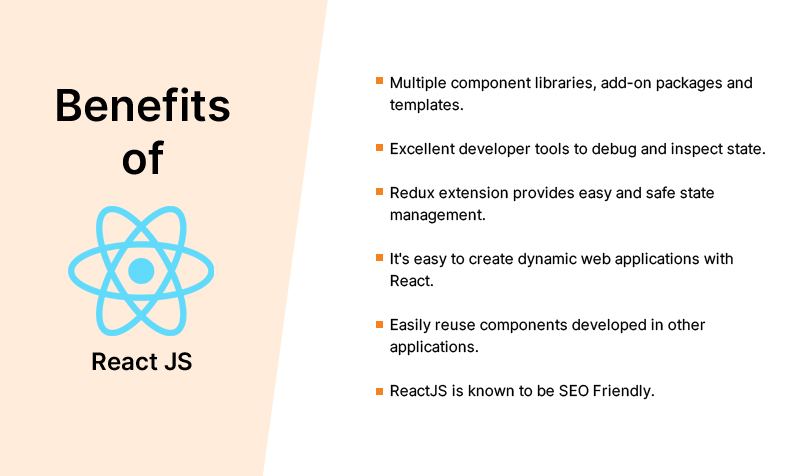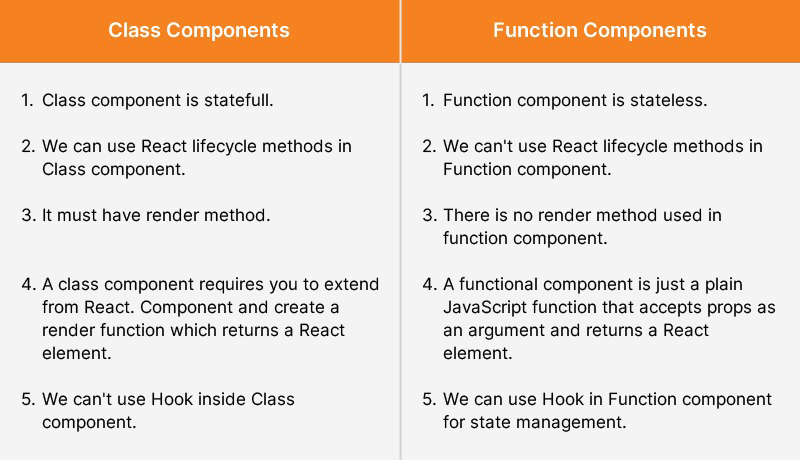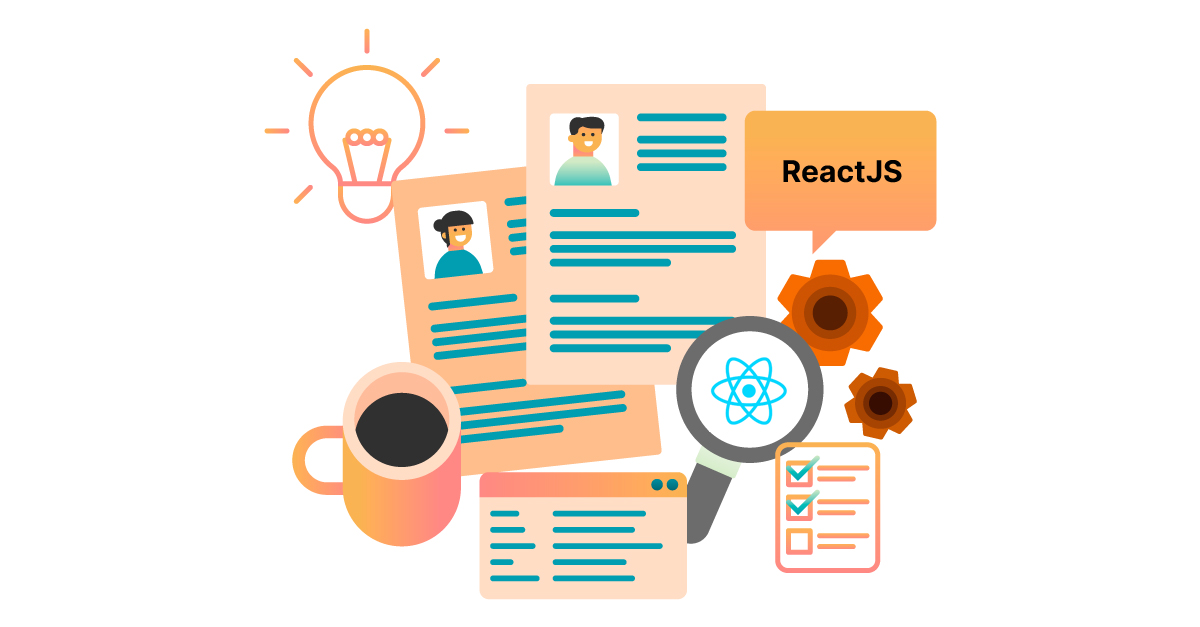Modern-day clients expect sleek, responsive, and high-performing web applications. And ReactJS, a front-end technology, is a fix to it! With its lightning-fast performance and unmatched user experience, ReactJS has created a buzz in web development.
Are you looking to hire ReactJS developers to meet evolving client needs and develop web apps that quickly respond to real-time events or ever-changing data for clients?
This guide has covered the crucial ReactJS interview questions from basic to advanced levels to simplify your interviewing process.
Top ReactJS Interview Questions and Answers
The skillset of a ReactJS developer is quite similar to that of a front-end developer. Below is a list of expertise that is typically expected from any ReactJS developer that knows their field:
- Highly skilled in front-end frameworks like Bootstrap or Foundation
- Quite familiar with CSS preprocessors like SASS and LESS
- Expertise in fundamentals of HTML, CSS, and JavaScript
- Knowledge of other JavaScript frameworks like Angular JS and Ember
- Very familiar with JavaScript libraries like jQuery or Backbone
You must ask the right questions to ensure your new hire has all these skill sets! Here’s the complete list of all the typical ReactJS interview questions.
The typical ReactJS interview questions are as follows:
Ques1: What is ReactJS, and who introduced it?
React is a declarative, efficient, and flexible JavaScript library developed by Facebook for building user interfaces.
Ques2: Is ReactJS Front-End or Back-End?
React JS, often known as React, is a front-end development framework, or, to be more precise, a library, that has become popular among developers worldwide. ReactJS distinguishes itself from other front-end development frameworks most frequently because of its speed, flexibility, usability, performance, and reusable components.
Ques3: What are the top React features which make it best for development?
Some of the top features of React are:
JSX: JavaScript XML is referred to as JSX. It is utilized with React to specify how the user interface ought to seem. JSX simplifies writing and adding HTML structures in the same file as JavaScript code.
Components: Everything is regarded as a component in React. Every element of the user interface has its own logic and design. Therefore, component logic written in JavaScript is simple, quick to execute, and reusable.
Virtual DOM: React maintains a compact version of the real DOM in memory, and this is referred to as the virtual DOM. The virtual DOM only modifies an object’s real-DOM counterpart when its state changes.
One-Way Data Binding: In React, one-way data binding denotes a unidirectional data flow. This indicates that data flow is one-way, from parent to child components or from top to bottom.
Ques4: What is Flux and its key components in ReactJS?
Flux is the application architecture used to build JavaScript applications for Facebook and is based on a unidirectional data flow. From small widgets to huge applications designed with Flux, React has handled everything thrown at it. Its key components include:
Actions: These facilitate the passing of data to the dispatcher. The data is packed into the action when fresh data enters the system via a user’s interaction with the application or via a web API call. These helper methods not only create the action object but also pass the action to the dispatcher.
Dispatcher: The dispatcher mustis required to provide a simple, synchronous iteration through the callbacks, invoking each in turn. After the entire set of dependencies has been fulfilled, the original callback continues to execute. In brief, a dispatcher receives actions and broadcasts payloads to the registered callbacks.
Stores: This component is required to manage the application state for a particular domain within your application. Thus, these stores manage the data, data retrieval methods, and dispatcher callbacks. These containers for application state and logic have callbacks registered to the dispatcher.
Controller views: This component listens to the change events and retrieves the application state from the stores. Afterward, they pass that data down to the child components through props.
Ques5: What is the difference between Flux and MVC?
Have you ever been to web application development? If yes, then you have some experience with MVC architecture. Various technologies, including ASP.NET, PHP, Ruby on Rails, JavaScript frameworks, and libraries, are excellent architecture for web applications. Talking about Flux, a new application architecture was introduced by Facebook in 2014 to overcome MVC architecture’s limitations. While Flux follows the concept of unidirectional data flow, MVC includes bidirectional data flow. Undeniably, unidirectional data flow reduces the probability of unpredicted data mutations.
Ques6: What’s the difference between Stateful and Stateless components in ReactJS?
Are you looking for software developers with a great understanding of React? Just make sure to ask this question. The stateless react components never change the state. Apart from this, they do not even access the data related to a state’s past, present, or future changes. On the contrary, the Stateful component changes its state and stores information about past, present, or future changes.
Ques7: What does State in React mean?
A built-in React object called the state is used to store data or details about the component. A component can have its state change over time, and each time it does, the component re-renders
Ques8: Are you aware of the difference between Props and State?
As you know, there is a thin line between the two, so it is essential to ask this question during the interview. Where the states are mutable, slower, and used as places where the data comes from, the props differ are exactly different. These are used to pass the data from the top-level components.
Ques9: What’s a Component in ReactJS?
Any React application is built from components, and a single app often comprises several components. In essence, a component is a portion of the user interface. It divides the user interface into separate, reusable components that may be handled independently.
In ReactJS, there are two sorts of components:
- Functional Components: Stateless components are another name for functional components, which have no state of their own and include render functions. They could get information from other props or components (properties).
- Class Components: These components include a distinct render method that returns JSX on the screen and the ability to store and maintain their own state. They can have a state, which is why they are sometimes known as stateful components.
Ques10: What does state in React mean?
A built-in React object called the state is used to store data or details about the component. A component can have its state change over time, and each time it does, the component re-renders.
Ques11: What are the benefits of React.js for application development?
The main advantages of using React.js for your application development goals are:
- React is declarative and offers easy data tracking and quick debugging capabilities.
- React.js is way faster than other frameworks, ensuring it works at lightning speed.
- One of the numerous advantages of adopting React.js for your project development is that it is mobile-friendly.
- You have the option to reuse development components as you go.
- The core of React.js is reliable and employs a downward data flow.
- React.js provides a broad range of development tools.

Ques12: ReactJS Lifecycle Methods: What are they?
The four stages that a React Component can go through are as follows:
- Initialization: The process when the component is made with the given Props and default state is called initialization. This is accomplished in a Component Class’s function Object() { [native code] }.
- Mounting: This is the process of rendering the JSX that the method itself returned.
- Update: This stage involves repainting the application and changing the state of a component.
- Unmounting: Removing the component from the page is the last step in the component lifecycle.
Ques13: In React, what do Props mean?
Properties are abbreviated as “props.” Similar to HTML attributes, it is a built-in React object that stores the value of a tag’s attributes. Props offer a method for transferring data across different components. The component receives props similarly to how arguments are supplied to a function.
Ques14: What are Higher-Order components?
A candidate can’t implement It is not possible for a candidate to implement a basic HOC pattern, as it will take more time than typically allotted for an interview. Instead, you can ask them to define HOC. Higher-order components are the React components that include other components.
Ques15: What is the difference between a Class and a Component?

You now have a comprehensive list of all the relevant ReactJS Interview Questions. Now to make your journey easier and save some bucks, you can consider hiring seasoned ReactJS developers from Netsmartz.
Hire a Resource From a ReactJS Development Company
These are all the most asked ReactJS interview questions to help you select the most qualified candidate. If you’re unsure whether you want to hire a resource for an in-house team or an external dedicated resource, Netsmartz has you covered.
Bring flexibility, agility & ease to your operations by hiring our ReactJS developers.
Request Free Consultation
Summary
Kickstart Your Project With Us!
Blog
Popular Posts
CONTACT US
Let's Build Your Agile Team.
Experience Netsmartz for 40 hours - No Cost, No Obligation.
Connect With Us Today!
Please fill out the form or send us an email to
 Don't Miss Out:
Don't Miss Out: 







